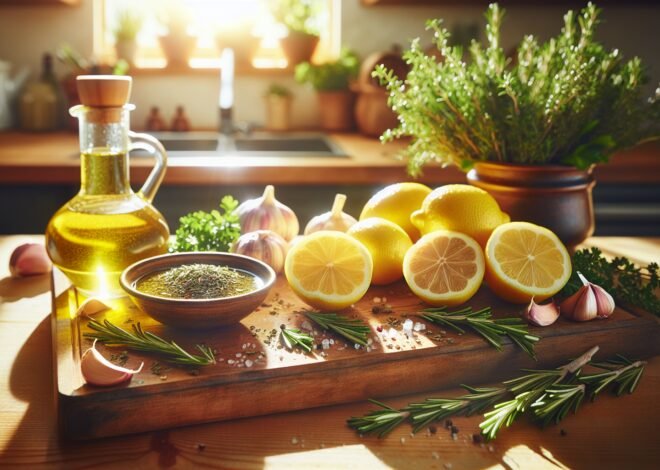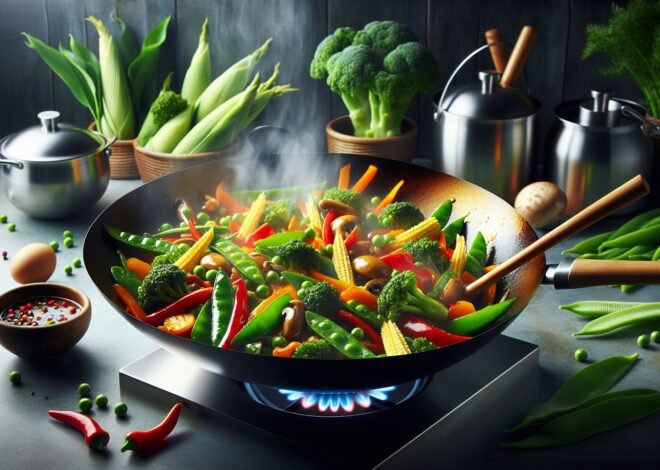
How to Properly Slice Ingredients for Stir-Frying Efficiency
Slice ingredients for stir-frying the right way to ensure speed and flavor in your dishes. Improperly sliced vegetables and meats can alter taste and cooking time, leading to less satisfying results. Mastering this fundamental skill ensures even cooking and enhances the stir-fry’s texture and taste. This guide covers essential techniques for slicing ingredients with precision, highlighting everything from knife choice to cutting styles. Dive in to elevate your cooking, make meal prep more efficient, and ensure your stir-fried delicacies are both flavorful and quick to prepare.
Understanding the Basics of Ingredient Preparation for Stir-Frying
Stir-frying is a popular cooking technique that delivers vibrant flavors swiftly. To perfect this art, mastering ingredient preparation is essential. The foundation of any successful stir-fry lies in the way ingredients are prepped. This involves honing your knife skills, picking the right tools, and ensuring uniformity in ingredient sizes to achieve even cooking.
Essential Knife Skills for Efficient Stir-Frying
The secret to efficient stir-frying often begins with your knife skills. A sharp knife is crucial, as it makes slicing through vegetables and proteins much easier. Practice basic cuts like julienne, dice, and mince to speed up your preparation time. These skills not only make prep work quicker but also enhance the texture and visual appeal of the dish.
- Hold the knife with a firm grip for better control.
- Use a rocking motion for uniform slices.
- Maintain a steady hand to ensure piece consistency.
Choosing the Right Tools and Equipment
Beyond knife skills, the tools you use can significantly impact your stir-frying experience. A wok is the traditional choice, allowing for even heat distribution and quick cooking. Ensure you have a sturdy cutting board to withstand repeated chopping. Additionally, a sharpener will keep your knives in top condition, and a spatula aids in stirring ingredients swiftly.
Importance of Uniformity in Cutting for Even Cooking
Uniformity in cutting is not just for aesthetics; it affects cooking times and texture. Ingredients cut to similar sizes cook at the same rate, preventing undercooked or overcooked pieces. This consistency is key in achieving the perfect stir-fry. Strive for even slices and cuts to ensure that flavors meld seamlessly during the cooking process.
Techniques for Slicing Vegetables for Stir-Fry Dishes
Vegetables add vibrant colors and textures to stir-fry dishes. Knowing the right slicing techniques can elevate the flavor profile of your stir-fry. Whether you’re julienning carrots or slicing leafy greens, each method serves a purpose in creating a well-rounded dish.
Julienne Cutting Technique for Maximum Flavor
The julienne cut involves slicing vegetables into thin matchstick-like pieces. This technique is perfect for items like carrots and bell peppers. Julienne cuts allow vegetables to cook quickly, releasing their flavors into the dish. This method also enhances the presentation of your stir-fry, adding elegance to the final plate.
- Start by trimming the ends of the vegetable.
- Cut into manageable sections for easier handling.
- Slice into thin, uniform strips for even cooking.
Dicing and Chopping Vegetables for Stir-Fry Efficiency
Dicing creates small, cube-like pieces that are ideal for quick, even cooking. This technique is excellent for onions and peppers, ensuring their flavors meld with the proteins. Chopping, on the other hand, is less precise and works well for ingredients like garlic and ginger, which infuse their essence throughout the dish.
- Start with a stable vegetable base on the cutting board.
- Make uniform vertical cuts, then slice horizontally.
- Aim for consistent piece size to ensure even cooking.
How to Slice Leafy Greens for Quick Cooking
Slicing leafy greens needs care to preserve their texture and color. These greens, like bok choy or spinach, should be sliced crosswise to keep their structure. Quick cooking methods ensure they retain their nutrients and vibrant coloration. Remember to wash them thoroughly before slicing to remove any grit.
Preparing Proteins for Stir-Frying Success
Proteins are the star of many stir-fry dishes, adding depth and richness. Proper preparation can elevate your stir-fry from ordinary to extraordinary. Whether working with chicken, beef, seafood, or tofu, the right cutting techniques ensure tender, flavorful results.
Best Practices for Slicing Chicken and Beef for Stir-Fry
For tender chicken and beef, slicing against the grain is key. This method reduces toughness and allows for better absorption of marinades. Aim for thin slices, which cook quickly and uniformly. Consider partially freezing your meats for more precise cutting, making the task easier.
- Identify the grain direction in the meat.
- Slice thinly across the grain.
- Use a sharp knife for clean cuts.
Preparing Seafood for Stir-Fry: Slices and Cuts
Seafood requires gentle handling and precise slicing. For shrimp, remove the shell and vein before slicing it lengthwise. Fish fillets should be cut into even pieces to cook uniformly. These delicate proteins cook rapidly, so keep an eye on the heat to avoid overcooking.
- Ensure seafood is fresh for the best results.
- Use a sharp knife to prevent tearing.
- Slice into even pieces for consistent cooking.
Techniques for Cutting Tofu and Plant-Based Proteins
Tofu and plant-based proteins require careful handling to maintain their integrity. Firm tofu should be pressed to remove excess moisture before slicing. Cube tofu for a hearty texture, or slice thinly for a lighter touch. These proteins absorb flavors well, making them versatile additions to stir-fry dishes.
- Press tofu to remove water for better texture.
- Use a sharp knife for clean cuts.
- Ensure even sizes for uniform cooking.
Conclusion
The article provides guidance on preparing ingredients for stir-frying, emphasizing the importance of uniform slicing. Consistent sizes ensure even cooking and enhance the dish’s flavor and texture. It highlights the need to cut vegetables and proteins against the grain for tenderness. Proper knife skills and using a sharp knife are crucial for efficiency. Prepping ingredients before cooking is essential to maintain high heat throughout the stir-frying process.
FAQ
How do you properly slice vegetables for stir-frying?
To slice vegetables for stir-frying, use a sharp knife and aim for uniform pieces. This ensures even cooking. Start by cutting vegetables into manageable sizes, then slice them thinly to allow for quick cooking at high heat.
What knife is best for slicing ingredients for stir-frying?
A chef’s knife or a santoku knife is ideal for slicing stir-fry ingredients. These knives offer precision and control, making it easier to achieve uniform slices. A sharp blade is crucial for efficient cutting.
What are the common mistakes when preparing stir-fry ingredients?
Common mistakes include uneven slicing, using dull knives, and overcrowding the pan. These issues can lead to uneven cooking and a less flavorful dish. Ensuring even cuts and not overcrowding will enhance the cooking process.
How thin should vegetables be sliced for a perfect stir-fry?
Vegetables should be sliced about 1/8 to 1/4 inch thick for stir-frying. This thickness allows them to cook quickly while maintaining a slight crunch, essential for a perfect stir-fry texture.
What is the best way to ensure even slicing for stir-fried dishes?
Use a mandoline or a sharp knife to achieve even slices. Consistency in size ensures all pieces cook at the same rate. Practice your slicing technique to enhance precision over time.
How does slicing size affect the cooking time in stir-frying?
Smaller, thinner slices cook faster than larger ones. Uniform, thin slices ensure quick, even cooking, preventing some ingredients from becoming overcooked while others remain undercooked.











